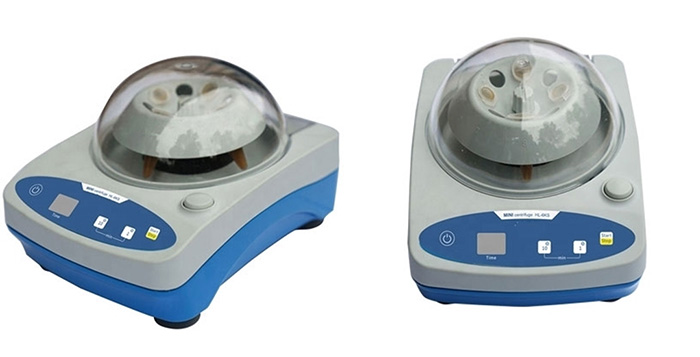Routine Maintenance of Centrifuge Machines
Centrifuges are essential equipment used in various industries such as pharmaceuticals, biotechnology, chemical engineering, food processing, and wastewater treatment. They are used to separate solid and liquid components from different mixtures, and they can perform this task at a rapid pace. However, centrifuges are complex machines that require proper maintenance to ensure their optimal performance, longevity, and safety. In this blog post, ATO will discuss the importance of centrifuge maintenance and provide some routine tips on how to maintain the centrifuge machine.

The importance of centrifuge maintenance
Centrifuges are often used in critical processes, and any malfunction or downtime can cause significant production losses and safety hazards. Therefore, it is essential to maintain centrifuges regularly to prevent any unexpected breakdowns, reduce repair costs, and ensure that they perform optimally. Regular maintenance also ensures the safety of the operators and the environment. Neglecting the maintenance of centrifuges can result in safety hazards, such as explosions, fires, and exposure to hazardous materials.
Routine maintenance of centrifuges
- When using various centrifuges, it is necessary to balance the centrifuge tube and its contents precisely on a balance beforehand. The weight difference during the balance must not exceed the range specified in the instructions for each centrifuge. Each different rotor has its own allowable deviation value, and odd-numbered tubes must not be loaded into the rotor. When the rotor is only partially loaded, the tubes must be symmetrically placed in the rotor to evenly distribute the load around the rotor.
- To centrifuge at temperatures below room temperature, the rotor should be pre-cooled in the refrigerator or in the rotor chamber of the centrifuge before use.
- During the centrifugation process, it is not allowed to leave at will, and whether the instrument on the centrifuge is working normally should be observed at any time, and if there is an abnormal sound, it should be stopped immediately for inspection and timely troubleshooting.
- Each rotor has its own maximum allowable speed and uses accumulation time, and the manual should be consulted when using the rotor, and it should not be used at excessive speed. Each rotor must have a usage file to record the accumulated usage time, and if the maximum usage time of the rotor is exceeded, it must be used at a reduced speed according to the regulations.
- When loading the solution, follow the specific operating instructions for each type of centrifuge. Select an appropriate centrifuge tube based on the properties and volume of the liquid to be centrifuged. Some centrifuge tubes do not have covers, and liquid should not be filled too much to avoid imbalance, rust, or corrosion of the rotor. For preparative ultracentrifuges, the centrifuge tubes often need to be filled completely to prevent deformation of the top of the plastic centrifuge tubes during centrifugation. After each use, carefully check the rotor, clean it, and dry it promptly. The rotor is a key component of the centrifuge that must be protected. Be careful when moving it and avoid collisions to prevent damage. If the rotor is not used for a long time, apply a layer of wax to protect it. Do not use centrifuge tubes that are visibly deformed, damaged, or aged.
Pay attention to:
- The power supply should be cut off before the centrifuge is running, the centrifuge brake should be released first, and the drum can be turned by hand to see if there is any jamming situation.
- Check for any looseness or abnormal conditions in other parts.
- Connect the power supply and start the machine in a clockwise direction (usually, it takes about 40-60 seconds from a stationary state to a normal operation).
- Usually, each device needs to run empty for about 3 hours after arriving at the factory and can work if there is no abnormality.
- The material should be placed as evenly as possible.
- Must be operated by special personnel, and the capacity shall not exceed the rated amount.
- It is strictly prohibited to operate the machine at an excessive speed to avoid affecting the service life of the machine.
- If there is an abnormality after the machine starts, it must be stopped for inspection, and disassembly, cleaning, and repair may be necessary if required.
- The centrifuge is running at high speed when working, so you must not touch its drum with your body to prevent accidents.
- The mesh size of the filter cloth should be determined according to the size of the solid particles of the separated material, otherwise, it will affect the separation effect. In addition, when installing the filter cloth, it should be embedded in the sealing groove of the drum to prevent materials from running into it.
- To ensure the normal operation of the centrifuge, lubricate the rotating parts every six months. At the same time, check the lubrication of the bearings, whether there is any wear and tear; whether the components in the braking device are worn, and replace them if they are severely damaged; whether there is any oil leakage in the bearing cover. After using the machine, clean it up and keep it tidy.
- Do not use non-corrosion-resistant centrifuges for the separation of highly corrosive materials. In addition, strictly follow the equipment requirements and regulations for operation. Non-explosion-proof centrifuges should not be used in flammable and explosive environments.
Centrifuges are essential machines used in various industries. Proper maintenance of these machines is crucial to ensure their optimal performance, longevity, and safety. Regular inspection, lubrication, cleaning, calibration, safety checks, and operator training are essential for the maintenance of centrifuges. By following these maintenance tips, operators can prevent unexpected breakdowns, reduce repair costs, and ensure the safety of the operators and the environment.
Contact ATO now to buy low-price centrifuge machines!

